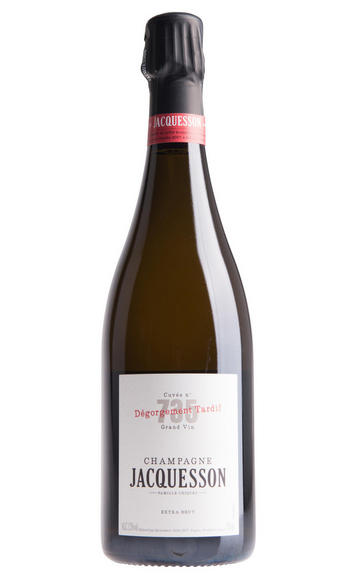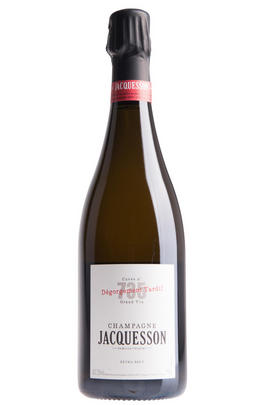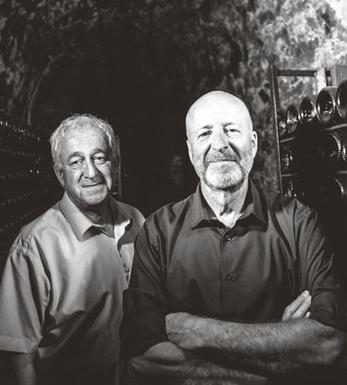
Champagne Jacquesson, Cuvée 735, Dégorgement Tardif, Brut

Critics reviews
Antonio Galloni - 31/10/2012
About this WINE

Jacquesson
Voted the third best of all Champagne Houses (after Bollinger and Krug) in 2005 La Revue Des Vins De France, Jacquesson has really come of age.
Based in the evocatively named town of Dizy, just to the north of Epernay, the House is run by the Chiquet brothers (cousins of our own Gaston Chiquet). The brothers are long-term advocates of the modish philosophy of zero dosage: this is put to the test in extremis with the equally modish move to release late disgorged cuvées: the juxtaposition of minimal sugar and extended lees ageing has produced these, some of the purest and most poised of all Champagnes, showing at their very best in magnum of course!
The house philosophy of releasing a clearly categorised Brut NV persists therefore, somewhat at odds with the historical precedent in the region which deliberately declines specifically to equate a batch with a certain vintage. Jacquesson's policy of so doing, albeit tangentially, is both a reflection of their adherence to the values of terroir and vintage diversity and a self-belief which over-rides any of the specific anxieties felt by the Champenois in relation to the conditions at a specific harvest.
These are very serious Champagnes with an emphasis on minerality and complexity of fruit. The wines have significant gravitas, are good food companions and age beautifully.

Brut Champagne
Brut denotes a dry style of Champagne (less than 15 grams per litre). Most Champagne is non-vintage, produced from a blend from different years. The non-vintage blend is always based predominately on wines made from the current harvest, enriched with aged wines (their proportion and age varies by brand) from earlier harvests, which impart an additional level of complexity to the end wine. Champagnes from a single vintage are labelled with the year reference and with the description Millésimé.
Non-vintage Champagnes can improve with short-term ageing (typically two to three years), while vintages can develop over much longer periods (five to 30 years). The most exquisite and often top-priced expression of a house’s style is referred to as Prestige Cuvée. Famous examples include Louis Roederer's Cristal, Moët & Chandon's Dom Pérignon, and Pol Roger's Cuvée Sir Winston Churchill.
Recommended Producers : Krug, Billecart Salmon, Pol Roger, Bollinger, Salon, Gosset, Pierre Péters, Ruinart

Pinot Noir
Pinot Noir is probably the most frustrating, and at times infuriating, wine grape in the world. However when it is successful, it can produce some of the most sublime wines known to man. This thin-skinned grape which grows in small, tight bunches performs well on well-drained, deepish limestone based subsoils as are found on Burgundy's Côte d'Or.
Pinot Noir is more susceptible than other varieties to over cropping - concentration and varietal character disappear rapidly if yields are excessive and yields as little as 25hl/ha are the norm for some climats of the Côte d`Or.
Because of the thinness of the skins, Pinot Noir wines are lighter in colour, body and tannins. However the best wines have grip, complexity and an intensity of fruit seldom found in wine from other grapes. Young Pinot Noir can smell almost sweet, redolent with freshly crushed raspberries, cherries and redcurrants. When mature, the best wines develop a sensuous, silky mouth feel with the fruit flavours deepening and gamey "sous-bois" nuances emerging.
The best examples are still found in Burgundy, although Pinot Noir`s key role in Champagne should not be forgotten. It is grown throughout the world with notable success in the Carneros and Russian River Valley districts of California, and the Martinborough and Central Otago regions of New Zealand.


Buying options
Add to wishlist
Description
The NV Brut Cuvee No. 735 caresses the palate from start to finish. Subtle and layered, the 735 is laced with dried pears, flowers and spices, all of which come together in an attractive, mid-weight style with considerable early appeal. I dont see the 735 improving much in bottle, but it is absolutely delicious today. The 735 is based on the 2007 vintage, with 28% Reserve wines. The blend is 47% Chardonnay, 33% Pinot Noir and 20% Pinot Meunier. Dosage was 3.5 grams per liter. This bottle was disgorged in October 2011. Anticipated maturity: 2012-2015.
Antonio Galloni - 31/10/2012
wine at a glance
Delivery and quality guarantee